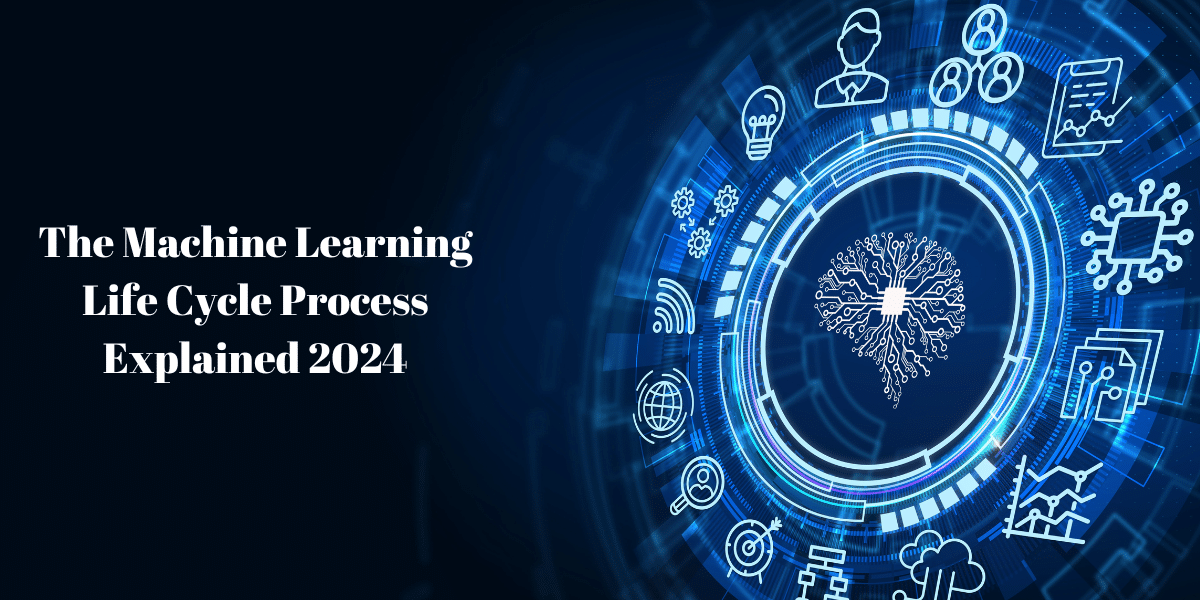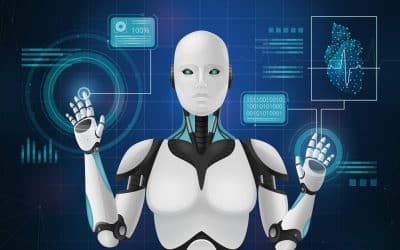Most machine learning (ML) initiatives involve modeling training, data processing, and deployment of models. There are many more. Creating and implementing artificial intelligence (AI) or machine learning initiatives is a continuous procedure. To ensure the project is successful, many processes will be repeated several times by ML Development Company to achieve the best performance. The system must be maintained following deployment and adjusted to the changing conditions.
There is a need for business and data knowledge, understanding of data collection techniques, data analytics, development of models, and modeling evaluation. Additionally, once we have deployed the model, it requires constant monitoring and upkeep. The machine learning life cycle comprises stages that structure the machine learning program and efficiently divide companies’ resources. Companies striving to remain competitive and meet changing business industry requirements must develop strategies incorporating information science.
In this blog post, we will look into the specifics of the lifecycle of a machine-learning model.
What Is Machine Learning Lifecycle
The Machine Learning Lifecycle represents a continuous process involving several aspects that make up an efficient machine-learning program. Each step in this cycle is governed by a quality control framework that ensures continuous improvement and maintenance while adhering to specific requirements and restrictions. Understanding that this constant process often calls for revisiting previous stages in light of knowledge gained in the subsequent phases is crucial.
The machine learning lifecycle describes the process of cyclical development to which data science projects adhere. It outlines the organization’s steps to use machine learning and artificial intelligence (AI) to gain tangible business benefits.
The Machine Learning Lifecycle
Each stage of the Machine Learning Development Services lifecycle is governed by a quality assurance structure that ensures continuous enhancement and improvement by adhering to the requirements and limitations. Here are a few steps of the entire life cycle of machine learning.
Planning
The first step in planning is to evaluate the extent, scope of operation, success criteria, and viability of an ML application. Knowing the company’s requirements and using machine learning to enhance the existing process is essential. For example, do we require machine learning? Do we have the ability to fulfill similar needs using simple programming?
Also, you must understand the cost-benefit analysis and determine what you plan to do with your solution over multiple stages. Additionally, it would help if you established clear and quantifiable measures of success for the business model, machine learning models (Accuracy F1 score, Accuracy AUC), and economy (a key indicator of performance).
Determine The Cause
The primary and fundamental stage for any machine-learning endeavor is clearly defining the issue. This is a crucial step because it determines the course for the entire project. Understanding the issue will ensure that resources are effectively allocated and that all efforts are focused on tackling the main issue. It is about defining the problem’s scope, delineating objectives, and determining the constraints and needs.
This methodical approach will reduce the possibility of diverting from the intended path and increase the probability of getting meaningful and practical outcomes. Thus, defining the issue precisely is the basis for the machine-learning experience.
Data Collection
After identifying and clarifying the issue, the data will be collected. We are machine learning learners, and many data acquisition tools exist. In most cases, data can be available online in CSV format on various websites, making the process much simpler. In other cases, we may need to use APIs to obtain information, which requires coding to retrieve data into JSON format. The data will later be converted into the format we want for study.
In more complicated scenarios, for instance, we have to resort to web scraping techniques to acquire data from websites for which the direct access option isn’t possible. However, direct access to data from a company’s production database is only sometimes practical, mainly if employed. When this happens, the data warehouses are created to remove, transform, and load the data, using the warehouse as a principal storage for data.
In addition, data can be dispersed across different groups, requiring data collection from various sources. Thus, collecting data requires navigating all these other avenues to efficiently identify and obtain the data needed.
Data Processing
Data preprocessing is a crucial stage in the machine-learning pipeline because it guarantees that the data you collect is reliable, precise, and suitable for accurate modeling. Most of the time, the information collected could be better; it could have structural problems and outliers. It could also be missing values, outliers, noise, or even differences in format because of different sources.
At this preprocessing stage, various tasks transform the data into a shape. This includes removing duplicates to make the dataset more efficient and processing missing data using methods of imputation or deletion. As well as identifying and dealing with the outliers that could affect the model’s performance, and standardizing the data dimensions to guarantee the sameness across different features.
The primary objective is to convert the initial data to a standard format that Machine Learning Development models easily understand. When we perform these processes carefully, we open the way to more precise model training and improve the quality and accuracy of our machine-learning solutions.
Exploratory Data Analysis
When we analyze data, we seek to understand the relationship between the features that are input and the output variable. It involves thoroughly exploring the data we have to discover patterns and relationships.
The most crucial aspect of the process is the visualization process, which allows us to present the data graphically to gain insights by employing methods like univariate analyses that examine each column, looking at the distributions, central tendencies, and variability. Bivariate analysis lets us analyze the relationship between groups of columns and identify relationships or potential dependencies. Additionally, multivariate analysis broadens the scope of this investigation to include interactions between multiple variables simultaneously.
Detecting outliers is an essential task in this process because the presence of outliers can significantly impact the efficiency and precision of the models we employ. In addition, we tackle issues based on biased or imbalanced information, ensuring that our analysis is not affected by the overrepresentation of data or inherent biases in the database. In analyzing and comprehending our data using a variety of lenses, we provide us with the knowledge needed to make informed choices and develop machine-learning solid models.
The Process Of Feature Engineering And Selection
These features, often described as inputs to machine learning, are a vital element in the final output of the model. They are the attributes or characteristics of the data utilized to create predictions or classes.
As part of the feature engineering process, we alter or design new features based on existing ones to improve the accuracy of our models. This may involve merging or changing features to gain more relevant data. For example, adding the bedrooms with bathrooms to get one metric, such as the total square footage, could provide an accurate representation of the size of a property.
Additionally, the selection of features is an essential step during the process of developing a model. We make a conscious effort to select the most critical characteristics from the array of inputs. It involves selecting and keeping only the ones that will significantly affect the desired variable, thus increasing effectiveness and model performance. When we carefully engineer and select options, we increase the ability of our model to detect relationships between the data and make accurate forecasts or decisions.
Model Training, Evaluation And Selection
After all desired characteristics are gathered, the following process is modeling. In this stage, we test various methods to evaluate their effectiveness in the information. It’s rare to depend entirely on a single algorithm. Instead, we assess multiple methods to determine the most suitable for our data and the problem.
When we apply each algorithm, we gather the results and evaluate their effectiveness using specified measures. These indicators provide insight into how each algorithm does based on precision, accuracy, F1-score, and other indicators of relevance. With these performance metrics, it is possible to compare the efficacy of various models.
After we’ve found a suitable algorithm, we move on to the tuning of parameters. Each algorithm has parameters of its own that are similar to settings that impact the model’s performance. Tuning parameters is a method of continuously altering these parameters to enhance our model’s performance using our dataset.
While continually testing and refining our models, we seek to determine the most efficient algorithm and refine its parameters to get the highest performance possible for our particular situation and data. The process is meticulous and ensures that our machine learning model is accurate, reliable, and appropriate for tackling the challenge.
Model Deployment
The algorithms that learn from the system are currently in use at this stage. Examples include adding automatic marking of the warehouse using the item’s design. We’ll integrate the computer vision model into the currently used system and use the camera pictures to print labels. The models can generally be deployed using the cloud, locally on a web browser or local server, and packaged as software and on edge devices. Then, you can use an API web app plugin, dashboard, or API.
In the deployment process, defining the hardware used to infer is necessary. We must ensure that we have sufficient storage, RAM, and computing power to deliver rapid outcomes. Then, we’ll test the model’s effectiveness in real-world production through A/B tests and ensure that the model is acceptable to users.
It is crucial to consider the deployment method. It is essential to ensure that changes go smoothly and improve the user experience. Furthermore, a project leader is required to create a disaster control strategy. This should contain an emergency plan, continuous surveillance, detection of anomalies, and reduction of damages.
Testing
Testing deployed is essential during development to determine its effectiveness under real-life scenarios. The most common approach used for testing is to use A/B tests. The A/B test is where users are split into two groups. One group interacts with the latest version of the model (control group) in contrast to the other group, which uses an upgraded version (experimental group). When we compare the results for both groups, we can determine the efficiency of the updated model.
If results from A/B testing do not meet the desired standards, it is essential to re-examine earlier phases of the development process to correct any flaws. The method iteration process ensures that the model is continually refined and improved to meet the requirements.
After completing the testing successfully and achieving satisfactory outcomes, the focus is now on optimizing the procedure. Optimizing involves fine-tuning various elements of the model. This includes improving its efficiency, scalability, or user experience to improve its efficiency and user-friendliness.
Through rigorous testing and optimization, the model can maintain its effectiveness and relevancy in meeting users’ requirements in various situations in the real world. Testing and optimizing are essential for the continual advancement and development of the system.
Monitoring And Maintenance
it is imperative to continuously monitor and enhance our process to ensure it is constantly improved and monitored. We’ll be keeping track of the model’s indicators, the hardware and software efficiency, and the satisfaction of customers. Monitoring is performed automatically, and specialists are alerted of issues, decreased model or hardware performance, or lousy customer reviews.
If we receive a lower warning about performance, we look into the problem and then try to build the model using the latest data or make adjustments to the architecture of the models. This is a continual procedure. Sometimes, it is necessary to overhaul the whole machine learning cycle to improve modeling and data processing techniques, update the equipment and software, and create a new framework to allow continuous integration.
What Are The Main Challenges To ML Lifecycle Management?
Let’s have a look at the challenge associated with machine learning lifecycle management.
Manual work
Every step, as well as the process of transitioning between them, is a manual process. Data scientists must manually gather and analyze each app’s data. They will have to look over their models from the past to design new ones and then manually tweak them every time. Much of the time is spent monitoring the model to avoid performance loss.
Teams Are Disconnected
Data scientists can create solid models of machine learning on their own. Successful implementation of a machine-learning model in a commercial scenario requires data scientists to cooperate with professional business people and designers, engineers, and various other groups. Collaboration can make the deployment process more complicated.
Scalability
The size of the data and the quantity of machine learning models increase the challenge of managing the entire procedure by hand. This could require multiple teams of data analysts to design the models, monitor them, and manage every model. There is no way in the capacity of an enterprise to expand its machine-learning applications while still relying on manual procedures.
What Are The Most Effective Ways To Manage The ML Lifecycle?
In this section, let’s look at the effective ways to manage the ML lifecycle. They are:
Automatization Of The Entire Process
Successful deployment of models based on machine learning on a large scale calls for complete automated steps throughout the process. Automating reduces time devoted to time-consuming processes like modeling engineering, feature engineering monitoring, retraining, and training. The time is free for rapid experimentation with different designs.
Standardization Of The Procedure
Data scientists must collaborate with various teams, which requires a common language. Standardizing an enterprise’s ML software development and management system allows effective communication among teams of different sizes.
Continuous Training
Data in the real world changes constantly. Therefore, a deployed ML model must also be continuously trained to ensure the model’s efficiency.
Conclusion
Engineers or Machine Learning Developers are mostly taught modeling, data processing, and learning; sometimes, they must be revised. They need to know about typical industrial quality assurance practices, including data collection and labeling methods and machine learning pipelines—the tracking of ML data, data versioning tests, or continuous monitoring and maintenance.
The data science lifecycle can be used as a reference for machine learning projects, and the stages need the right tools to meet set objectives. This provides a clear overview of each step in the Machine Learning development process; using this simple outline, it’s easy to be aware of the actions to follow in conducting the ML project.
A well-planned business plan backed by organized efforts by teams at every phase of the process can drastically improve the performance and effectiveness of ML solutions. It can result in better results for both the company and the end user regarding the value they see.











